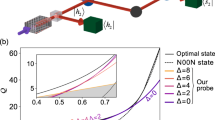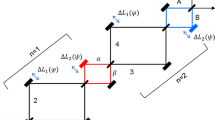Abstract
Precise interferometric measurement is vital to many scientific and technological applications. Using quantum entanglement allows interferometric sensitivity that surpasses the shot-noise limit (SNL)1,2. To date, experiments demonstrating entanglement-enhanced sub-SNL interferometry3,4,5,6, and most theoretical treatments7,8,9,10,11,12,13, have addressed the goal of increasing signal-to-noise ratios. This is suitable for phase-sensing—detecting small variations about an already known phase. However, it is not sufficient for ab initio phase-estimation—making a self-contained determination of a phase that is initially completely unknown within the interval [0, 2π). Both tasks are important2, but not equivalent. To move from the sensing regime to the ab initio estimation regime requires a non-trivial phase-estimation algorithm14,15,16,17. Here, we implement a ‘bottom-up’ approach, optimally utilizing the available entangled photon states, obtained by post-selection5,6. This enables us to demonstrate sub-SNL ab initio estimation of an unknown phase by entanglement-enhanced optical interferometry.
This is a preview of subscription content, access via your institution
Access options
Subscribe to this journal
Receive 12 print issues and online access
$209.00 per year
only $17.42 per issue
Buy this article
- Purchase on Springer Link
- Instant access to full article PDF
Prices may be subject to local taxes which are calculated during checkout



 for varying total photon number N.
for varying total photon number N.
Similar content being viewed by others
References
Giovannetti, V., Lloyd, S. & Maccone, L. Quantum-enhanced measurements: beating the standard quantum limit. Science 306, 1330–1336 (2004).
Wiseman, H. M. & Milburn, G. J. Quantum Measurement and Control (Cambridge Univ. Press, 2010).
Meyer, V. et al. Experimental demonstration of entanglement-enhanced rotation angle estimation using trapped ions. Phys. Rev. Lett. 86, 5870–5873 (2001).
Leibfried, D. et al. Creation of a six-atom ‘Schrödinger cat’ state. Nature 438, 639–642 (2005).
Nagata, T., Okamoto, R., O'Brien, J. L., Sasaki, K. & Takeuchi, S. Beating the standard quantum limit with four-entangled photons. Science 316, 726–729 (2007).
Okamoto, R. et al. Beating the standard quantum limit: phase super-sensitivity of N-photon interferometers. New J. Phys. 10, 073033 (2008).
Caves, C. M. Quantum-mechanical noise in an interferometer. Phys. Rev. D 23, 1693–1708 (1981).
Yurke, B., McCall, S. L. & Klauder, J. R. SU(2) and SU(1,1) interferometers. Phys. Rev. A 33, 4033–4054 (1986).
Summy, G. S. & Pegg, D. T. Phase optimized quantum states of light. Opt. Commun. 77, 75–79 (1990).
Holland, M. J. & Burnett, K. Interferometric detection of optical phase shifts at the Heisenberg limit. Phys. Rev. Lett. 71, 1355–1358 (1993).
Sanders, B. C. & Milburn, G. J. Optimal quantum measurements for phase estimation. Phys. Rev. Lett. 75, 2944–2947 (1995).
Lee, H., Kok, P. & Dowling, J. P. A quantum Rosetta stone for interferometry. J. Mod. Opt. 49, 2325–2338 (2002).
Steuernagel, O. De Broglie wavelength reduction for a multiphoton wave packet. Phys. Rev. A 65, 033820 (2002).
Braunstein, S. L. How large a sample is needed for the maximum likelihood estimator to be approximately Gaussian? J. Phys. A 25, 3813–3826 (1992).
Durkin, G. A. & Dowling, J. P. Local and global distinguishability in quantum interferometry. Phys. Rev. Lett. 99, 070801 (2007).
Higgins, B. L., Berry, D. W., Bartlett, S. D., Wiseman, H. M. & Pryde, G. J. Entanglement-free Heisenberg-limited phase estimation. Nature 450, 393–396 (2007).
Berry, D. W. et al. How to perform the most accurate possible phase measurements. Phys. Rev. A 80, 052114 (2009).
Sanders, B. C. Quantum dynamics of the nonlinear rotator and the effects of continual spin measurement. Phys. Rev. A 40, 2417–2427 (1989).
Cable, H. & Dowling, J. P. Efficient generation of large number–path entanglement using only linear optics and feed-forward. Phys. Rev. Lett. 99, 163604 (2007).
Walther, P. et al. De Broglie wavelength of a non-local four-photon state. Nature 429, 158–161 (2004).
Mitchell, M. W., Lundeen, J. S. & Steinberg, A. M. Super-resolving phase measurements with a multiphoton entangled state. Nature 429, 161–164 (2004).
Afek, I., Ambar, O. & Silberberg, Y. High-NOON States by mixing quantum and classical light. Science 328, 879–881 (2010).
Berry, D. W. & Wiseman, H. M. Optimal states and almost optimal adaptive measurements for quantum interferometry. Phys. Rev. Lett. 85, 5098–5101 (2000).
Berry, D. W., Wiseman, H. M. & Breslin, J. K. Optimal input states and feedback for interferometric phase estimation. Phys. Rev. A 63, 053804 (2001).
Thomas-Peter, N. L., Smith, B. J., Dorner, U. & Walmsley, I. A. Real-world quantum sensors: evaluating resources for precision measurement. Preprint at http://arxiv.org/abs/1007.0870 (2010).
Kacprowicz, M. et al. Experimental quantum-enhanced estimation of a lossy phase shift. Nature Photon. 4, 357–360 (2010).
Cable, H. & Durkin, G. A. Parameter estimation with entangled photons produced by parametric down-conversion. Phys. Rev. Lett. 105, 013603 (2010).
Lee, T.-W. et al. Optimization of quantum interferometric metrological sensors in the presence of photon loss. Phys. Rev. A 80, 063803 (2009).
Knysh, S., Smelyanskiy, V. N. & Durkin, G. A. Scaling laws for precision in quantum interferometry and bifurcation landscape of optimal state. Preprint at http://arxiv.org/abs/1006.1645v2 (2010).
Politi, A., Matthews, J., Thompson, M. G. & O'Brien, J. L. Integrated quantum photonics. IEEE J. Sel. Top. Quant. Electron. 15, 1673–1684 (2009).
Aspachs, M., Calsamiglia, J., Muñoz-Tapia, R. & Bagan, E. Phase estimation for thermal Gaussian states. Phys. Rev. A 79, 033834 (2009).
Acknowledgements
The authors thank J. O'Brien for helpful discussions. This work was supported by the Australian Research Council.
Author information
Authors and Affiliations
Contributions
G.J.P. devised and designed the experiment. H.M.W. devised and analysed the theoretical approach. G.Y.X. constructed and operated the experiment, and collected the data. B.L.H. automated and experimentally implemented the feedback algorithm, and contributed to the operation of the apparatus. D.W.B. constructed and performed numerical simulations of the algorithm, and performed numerical processing of results. All authors contributed to the manuscript.
Corresponding authors
Ethics declarations
Competing interests
The authors declare no competing financial interests.
Supplementary information
Rights and permissions
About this article
Cite this article
Xiang, G., Higgins, B., Berry, D. et al. Entanglement-enhanced measurement of a completely unknown optical phase. Nature Photon 5, 43–47 (2011). https://doi.org/10.1038/nphoton.2010.268
Received:
Accepted:
Published:
Issue Date:
DOI: https://doi.org/10.1038/nphoton.2010.268
This article is cited by
-
Phase estimation of definite photon number states by using quantum circuits
Scientific Reports (2023)
-
Experimental metrology beyond the standard quantum limit for a wide resources range
npj Quantum Information (2023)
-
Theoretical studies on quantum imaging with time-integrated single-photon detection under realistic experimental conditions
Scientific Reports (2022)
-
Multi-channel quantum parameter estimation
Science China Information Sciences (2022)
-
Enhancing the precision of multi-parameter estimation for two-level open quantum system by mixed control
Quantum Information Processing (2022)



